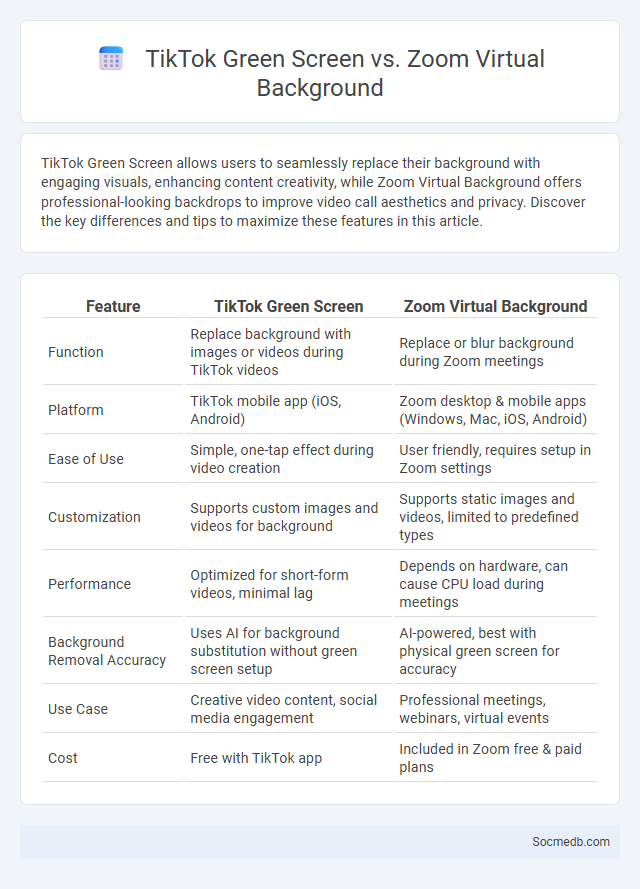
Photo illustration: TikTok Green Screen vs Zoom Virtual Background
TikTok Green Screen allows users to seamlessly replace their background with engaging visuals, enhancing content creativity, while Zoom Virtual Background offers professional-looking backdrops to improve video call aesthetics and privacy. Discover the key differences and tips to maximize these features in this article.
Table of Comparison
| Feature | TikTok Green Screen | Zoom Virtual Background |
|---|---|---|
| Function | Replace background with images or videos during TikTok videos | Replace or blur background during Zoom meetings |
| Platform | TikTok mobile app (iOS, Android) | Zoom desktop & mobile apps (Windows, Mac, iOS, Android) |
| Ease of Use | Simple, one-tap effect during video creation | User friendly, requires setup in Zoom settings |
| Customization | Supports custom images and videos for background | Supports static images and videos, limited to predefined types |
| Performance | Optimized for short-form videos, minimal lag | Depends on hardware, can cause CPU load during meetings |
| Background Removal Accuracy | Uses AI for background substitution without green screen setup | AI-powered, best with physical green screen for accuracy |
| Use Case | Creative video content, social media engagement | Professional meetings, webinars, virtual events |
| Cost | Free with TikTok app | Included in Zoom free & paid plans |
Overview: Virtual Backgrounds and Green Screens Explained
Virtual backgrounds and green screens enhance video calls and content creation by replacing the real background with digital images or videos, boosting engagement and professionalism. These technologies utilize chroma keying to detect a solid green backdrop and seamlessly swap it with any chosen visual, often without expensive setups. Popular on platforms like Zoom, Microsoft Teams, and OBS Studio, virtual backgrounds enable users to maintain privacy, set thematic moods, and create immersive social media content effortlessly.
What is TikTok Green Screen Feature?
TikTok's Green Screen feature allows you to replace your background with any image or video, creating immersive and creative content without needing a physical green screen. This tool enhances your videos by enabling seamless integration of custom visuals, perfect for storytelling, tutorials, or entertainment. Your content can stand out by utilizing this advanced effect to engage viewers and boost interaction on the platform.
Zoom Virtual Background: Key Functions and Benefits
Zoom virtual backgrounds enhance your video meetings by allowing you to replace or blur your actual surroundings, providing a professional and distraction-free environment. Key functions include customizable background images, support for video backgrounds, and the option to use green screen technology for better visual clarity. These features improve engagement and privacy, making your virtual interactions more impactful and secure.
Traditional Green Screen: How It Works
Traditional green screen technology works by filming subjects against a uniformly green backdrop, which is later replaced with digital backgrounds in post-production using chroma keying techniques. This method relies on the distinct color contrast between the green screen and the subject to isolate and remove the green areas, allowing seamless integration of various visual elements. Social media content creators use green screens to enhance video quality, create immersive environments, and engage audiences with dynamic visuals.
Visual Quality: Comparing Output Results
Visual quality on social media significantly impacts user engagement, as high-resolution images and vibrant colors attract more attention and shares. Platforms like Instagram and Pinterest prioritize crisp, clear visuals, influencing the way content creators optimize their output to maintain brand consistency and appeal. Enhancing your visual content ensures better viewer retention and can elevate your social media presence effectively.
Ease of Use: User Experience Across Platforms
Social media platforms prioritize intuitive design and seamless navigation to enhance ease of use, ensuring users can effortlessly create, share, and consume content. Features such as personalized feeds, simple posting interfaces, and integrated multimedia support contribute to a smooth user experience across platforms like Facebook, Instagram, Twitter, and TikTok. Consistent updates and responsive customer support further optimize usability, encouraging prolonged engagement and satisfaction.
Hardware & Space Requirements
Social media platforms demand robust hardware infrastructure, including high-performance servers and ample storage capacity, to manage vast amounts of user-generated content efficiently. Your systems must accommodate scalable bandwidth and processing power to ensure seamless content delivery and real-time interactions. Optimizing data center space with energy-efficient hardware can further enhance performance while reducing operational costs.
Customization and Creative Flexibility
Social media platforms offer unparalleled customization options that allow you to tailor your content and profile to reflect your unique brand identity. Creative flexibility enables you to experiment with various formats such as images, videos, stories, and reels, enhancing engagement and audience connection. Leveraging these tools effectively can drive stronger interaction and growth for your social media presence.
Limitations and Common Issues
Social media platforms often face limitations such as algorithmic bias, data privacy concerns, and the spread of misinformation, impacting user trust and content quality. Common issues include cyberbullying, excessive screen time leading to mental health problems, and echo chambers that reinforce existing beliefs without exposing users to diverse perspectives. These challenges necessitate ongoing regulatory scrutiny and technological advancements to create safer, more transparent social networking environments.
Best Use Cases: Which Option Suits Your Needs?
Social media platforms offer diverse best use cases tailored to different goals such as brand awareness, customer engagement, and lead generation. For businesses seeking visual storytelling, Instagram and Pinterest excel, while LinkedIn suits professional networking and B2B marketing needs. Understanding the strengths of each option helps you select the platform that aligns perfectly with your target audience and marketing objectives.
 socmedb.com
socmedb.com